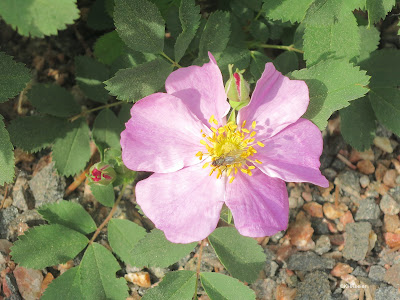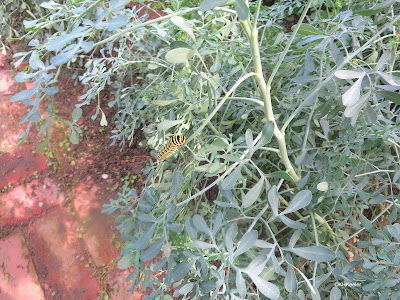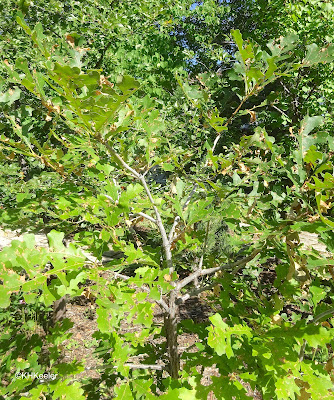 |
| Colorado columbines (Aquilegia coerulea) and golden banner (Thermopsis rhombifolia) |
Five or so years ago, only a very occasional person planted natives in their yard. Now there is a widespread call for them. Nurseries that specialize in natives label the plant as native or not, but most places the tag on the plant just gives a common name and whether it needs full sun. Identifying the origin of the plant is a new problem for many people and stores.
Here are some of the issues that make choosing and buying a local native surprisingly difficult.
Many native plants have lots of relatives all around the world. People remember familiar names more easily that new ones, so we often call all those plants by the same common name. Rose, for example. Seriously. Native where I live are Wood's rose, Rosa woodsii, the prickly rose, Rosa acicularis, and the prairie rose, Rosa arkansana. The other 297 species in the genus Rosa are not. Some are native to Europe, others to China and Japan. If I walk into the plant store to buy a rose for my yard, odds are I won't get a native rose. When the website tells you roses are native where you live, that just begins the process.
Will a Chinese rose or a hybrid tea rose feed the same insects as the prairie rose? That is a really good question and I'm searching to see if any useful data has been published. So far it looks like nobody knows. Minimally though, if you spray your roses with pesticides, they won't feed insects or produce caterpillars for birds to eat.
Other native plants have look-alikes from Eurasia that are much easier to buy than the natives. For me, blue flax is one of those. European blue flax is Linum perenne, also called perennial flax. Lewis's flax, also called blue flax and also perennial, Linum lewisii, is native where I live. The blue flax in the pot at the nursery is usually European blue flax, though the pot may just say "blue flax." And European blue flax has escaped and is a weed across the Colorado Front Range, so it is a familiar "wild" flower.
Even within North America, most wildflowers had a limited range, maybe as large as the Eastern U.S. or the Rocky Mountains, but not from the Atlantic to the Pacific. So when they say "plant goldenrods" or "grow an oak," there are actually dozens to choose from, only a few of which are native in a particular area. So buying the first goldenrod you see on a seed company website may or may not give you a plant local to your area and, of course, it may or may not grow well where you live.
Our natives are increasingly rare; we didn't value them and we are given substitutes when we try to plant them.
 |
| wild rose, likely Rosa woodsii, with fly (birds find flies very tasty) |
Mind you, I am part of the problem. When I go to buy an aster (Symphytotrichium) and the only ones available not the species on my list, it is hard to walk away without a plant. "Ok, I'll try it."
The seed companies and plant companies are trying to respond to the sudden demand for natives, but plants take a while to grow and multiply. Some natives are easy for plant companies to grow in gardens or greenhouses and so are easy to buy. These are native somewhere but of course not everywhere. Other plants don't grow fast or multiply rapidly so are in short supply. The store offers me the aster it has; it cannot offer the aster it doesn't have.
Where I am going with this is: planting natives is going to be a process. Celebrate the one or two local species you find. Add others as they become available.
For now, look carefully at your tea roses, Japanese maples, grapes, Florentine iris and other exotic plants that have close relatives in North America. Do insects eat the leaves? Do butterflies land and feed on the flowers or do they circle and move on? While native plant supply catches up, favor the insect-supporting plants you have.
There are a lot of very familiar plants that have no close American relatives and that have few or no native insects that can feed on them. Those include daffodils, daylilies, lilacs, canna lilies, boxwood, petunias, and many others. They were promoted as having few pest problems--nothing can eat them because they are toxic to our native insects. Hmmm. Shift the balance in your yard to more edible plants. Put up with leaf holes.
And, look carefully at the exotics you are growing, too. Rue (Ruta graveolens, rue family Rutaceae) is a European plant famous for tasting bitter. And yet, I saw lots of swallowtail caterpillars feeding on it on a trip to Pennsylvania. A few native insects do eat introduced garden plants.
 |
| swallowtail butterfly caterpillar on rue (Ruta graveolens) Rue has no close American relatives but is feeding this native butterfly's caterpillar |
Growing natives is new to most of us. It is going to be a learning process, an adventure.
Comments and corrections welcome.
Kathy Keeler, A Wandering Botanist
More at awanderingbotanist.com
Join me on Facebook: https://www.facebook.com/AWanderingBotanist


No comments:
Post a Comment